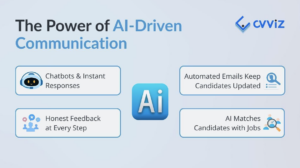The recruitment industry is an ever-evolving entity, adapting to changes in the business landscape. Its role in any organization’s success is undeniably crucial. From startups to multinational corporations, finding the right talent fuels growth, innovation, and competitive advantage. However, in today’s fast-paced digital age, sticking to conventional methods can spell stagnation. Businesses must navigate the shifting recruitment landscape using modern strategies to stay ahead of the curve.
The Changing Recruitment Landscape
Consider recruiting in the “good old days”. Picture a beleaguered HR professional, surrounded by towering stacks of resumes, sifting through each one in the quest for the ideal candidate. Now, fast-forward to today. That image couldn’t be further from the reality of modern recruitment. The recruitment landscape has changed dramatically in this digital age, taking a quantum leap from the traditional methods we once knew.
Shift from Traditional to Digital Recruitment Methods
Traditional recruitment, characterized by manual resume screening and in-person interviews, is rapidly giving way to digital alternatives. The introduction of AI recruiting software has revolutionized how HR teams source and shortlist potential candidates. Moreover, technology has made geographical barriers obsolete, opening up a global talent pool.
Impact of Technology on Recruitment
From job postings to candidate assessments, technology has integrated itself into every aspect of recruitment. The use of AI, data analytics, and even virtual reality has automated mundane tasks, made processes more efficient, and enhanced decision-making.
Embracing Digital Technologies for Recruitment
Gone are the days when recruiters had to rely solely on their intuition and manual processes to attract, engage, and hire talent. We’re riding the crest of a wave in a sea of change, where tech-savviness has become an invaluable asset in the recruiting world. Here, we’re diving into the realm of digital technologies – AI, data analytics, VR/AR – that are not just bells and whistles but powerful tools reshaping the recruitment landscape. So buckle up, and let’s explore this digital wonderland.

Artificial Intelligence (AI) and Machine Learning
Imagine you’re at a party and have to find a person who loves Star Trek and quantum physics in a crowd of hundreds. Exhausting, right? That’s what traditional resume screening felt like.
AI-powered resume screening and candidate matching: AI and machine learning are the game-changers here, doing the heavy lifting at record speed. They can sift through heaps of resumes, spotlighting candidates who best fit specific job requirements.
Chatbots for initial candidate engagement and FAQ handling: If AI is a party magician, chatbots are the charismatic hosts. They field candidate queries round-the-clock, improving initial engagement and allowing HR teams to zero in on strategic tasks.
Data Analytics and Predictive Hiring
Data analytics in recruitment is like having a crystal ball, revealing patterns, and offering foresight, making the hiring process more innovative and efficient.
- Leveraging data to make informed hiring decisions: HR teams now use big data to glean insights, track trends, and understand candidate behavior. They’re not just making decisions; they’re making informed decisions.
- Predictive analytics for identifying high-potential candidates: It’s all about staying one step ahead. Predictive analytics provides a sneak peek into a candidate’s future performance, helping recruiters spot high-potential gems early.
Virtual and Augmented Reality (VR/AR)
VR/AR has moved beyond just being buzzwords and is opening new frontiers in the recruitment world.
- Virtual job fairs and remote interviewing: Welcome to the era of remote work where distance is no longer a deal-breaker, and virtual job fairs and interviews have become as routine as morning coffee. Consider including recorded video content to modernize your job fair, as it can add depth and personality. It’s here that tools such as a video editor and audio joiner come in handy. Think of them as your behind-the-scenes tech wizards, spicing up your virtual interactions. A video editor tool allows you to create professional, polished interview presentations that leave a lasting impression on potential candidates. An audio joiner tool, on the other hand, deals with multi-participant interviews. It ensures the interview’s audio flows smoothly, making the conversation natural and consistent, as if everyone were sitting in the same room. Together, these tools enhance the effectiveness of your virtual interactions, adding that extra dash of personal touch and professionalism.
- Simulated job previews and assessments: What if candidates could walk a mile in their future job’s shoes before starting? VR/AR makes this possible with realistic job previews and immersive assessment experiences, offering both parties a “try-before-you-buy” experience. The integration of VR/AR in recruitment also enhances the organization’s appeal to candidates. It demonstrates that the company is forward-thinking and willing to invest in state-of-the-art technology to ensure a good fit between the job and the candidate. This “try-before-you-buy” experience goes a long way in improving the candidate experience, boosting the employer brand, and ultimately, enhancing the quality of hires.
Enhancing Candidate Experience with Technology
Welcome to the realm of enhancing the candidate experience with technology, where we believe that the right mix of personalization and convenience can elevate recruitment to an entirely new level.
Personalized Recruitment Experiences
- Tailored job recommendations and content: AI-powered systems can personalize job recommendations based on candidate profiles, preferences, and behavior, improving the candidate experience.
- Customized communication and engagement: Personalized communication and engagement strategies using AI help maintain candidate interest and encourage a positive perception of the organization.
Mobile Recruiting
- Mobile-optimized application processes: Simplifying and mobile-optimizing the application process can increase the number of applications and improve candidate experience.
- Mobile apps for candidate engagement and updates: Mobile apps provide a platform for continuous engagement, offering job alerts, updates, and feedback options.
Building Employer Branding with Digital Tools
When it comes to building employer branding, digital tools have become the paintbrushes of our era. They allow us to craft and showcase our corporate identity in a way that resonates with potential candidates.
First off, social media platforms aren’t just for sharing cat videos anymore. They’ve become a compelling canvas for us to portray our company culture, voice our values, and engage potential talent. We’re not just broadcasting our message into the void – we’re using these platforms to connect with potential candidates, answer their questions, and foster meaningful relationships. It’s like having a coffee chat with a potential hire, but online.
Then there are employer review sites and TripAdvisor for job seekers, if you will. Actively monitoring and responding to online reviews is a bit like customer service – it’s about showing that we value feedback and are dedicated to improving. This active management can sway public perception and guide candidate decisions.
Finally, let’s talk about reputation management. It’s not just about avoiding scandals but proactively building a positive image online. This can make all the difference in attracting high-quality candidates, like a well-lit sign in the night drawing in the right people. So, digital tools are not just about maintaining our image but actively sculpting it to build a robust and appealing employer brand.
Ethical Considerations and Mitigating Bias in Recruitment
In the fast-paced race towards technological advancement, it’s essential we don’t overlook one crucial aspect – ethics. Particularly in recruitment, as we integrate AI and machine learning, we must also mitigate bias and uphold fairness.
Let’s get real; while technology has brought about a seismic shift in recruitment, it’s not without its pitfalls. AI and machine learning models can unintentionally learn and replicate biases present in the data they’re trained on. This could lead to specific demographics being unfairly disadvantaged. That’s why training these models with diverse and unbiased data and conducting regular audits is essential. But it’s not all up to the machines. We, the humans, must also step up our game. Implementing structured interviews and conducting blind assessments can help reduce human bias, ensuring a level playing field for all candidates. Ultimately, staying ahead in recruitment is not just about embracing new strategies but doing so responsibly and ethically.
Overcoming Challenges and Obstacles
Navigating the future of recruitment isn’t just a smooth sail; it’s a journey with challenges and obstacles that we must skillfully maneuver. As we transition into digital recruitment strategies, two key hurdles often rear their heads: security and privacy concerns and skill gaps within HR teams.
Firstly, as we deal with massive volumes of candidate data, there’s an increasing need to protect this information and maintain privacy. It’s like we’re the guardians of a digital Fort Knox, responsible for safeguarding candidate data and ensuring compliance with data protection regulations. This task requires a clear understanding of cybersecurity principles and strict adherence to data privacy laws.
Secondly, the shift to a tech-centric approach has brought the challenge of skill gaps within HR teams. Not everyone is a tech whizz, right? But fear not; this is where upskilling comes into play. We can effectively bridge this gap by equipping our HR teams with the necessary skills to handle new technologies and collaborating with technology vendors for training and support.
In essence, overcoming these challenges isn’t a blockade but rather a stepping stone to propel us further into the digital recruitment future.
Conclusion
In the dynamic world of recruitment, businesses must adapt or risk falling behind. As we’ve explored, embracing technologies like AI recruiting software, data analytics, and virtual reality can revolutionize the recruitment process. Personalizing the candidate experience and managing your online reputation can further enhance your appeal to potential candidates. However, amidst the excitement of technology, don’t forget the ethical considerations, and remember to safeguard candidate data.
The future of recruitment is already here. It’s time for businesses to fully embrace these technologies and trends, stay agile, and prepare for future advancements. It’s not just about keeping pace – it’s about staying ahead.



